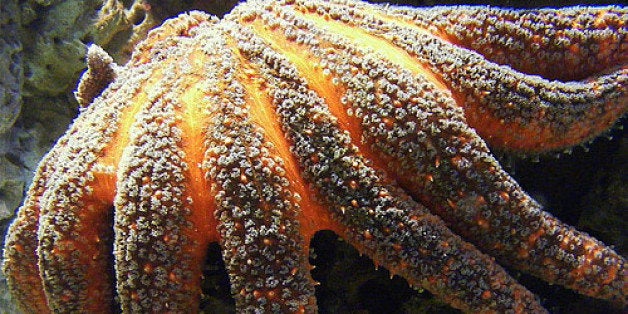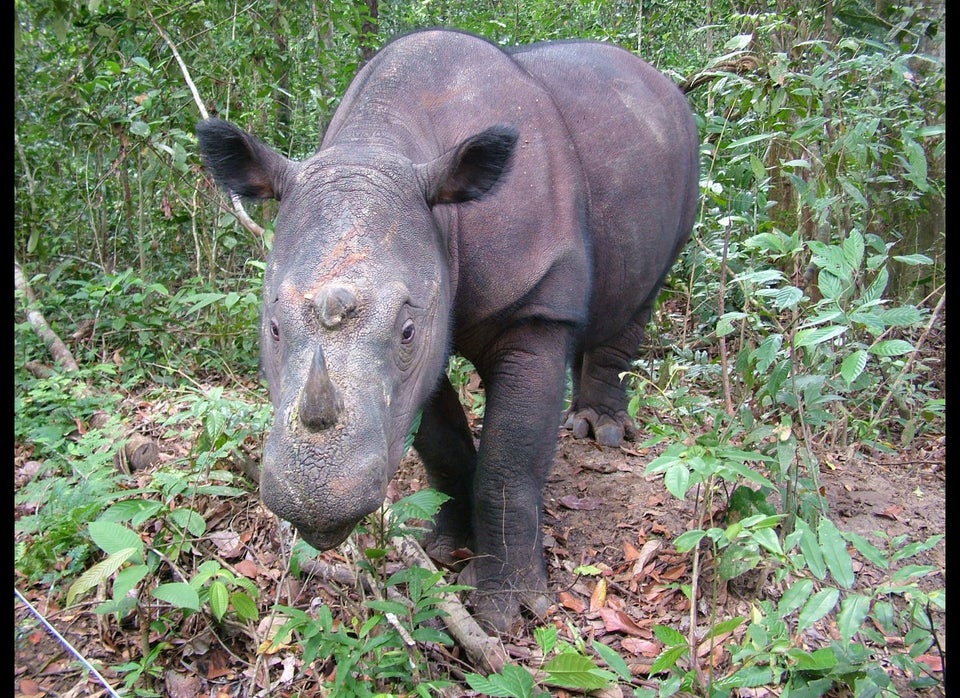
For many animal species, it's a good thing 2013 is winding down. It was simply not their time to shine, and they need a new year to give them another chance at a clean bill of health.
This past year opened with tragic news of sea lion pups stranding along Southern California. Then our hearts all sank as we heard about bottlenose dolphin die-offs along the Atlantic Coast, and now, we're concluding the year with mysterious eagle deaths in Utah.
Fortunately, there were success stories among the doom and gloom. The adorable puffin rebounded off the coast of Maine after previously being decimated by fishermen, and green sea turtle nests surged in Florida, where they are listed as endangered under the Endangered Species Act.
In 2014, let's hope that some of these mysteries are solved for the better protection, conservation and longevity of many species. And in addition to preventing die-offs from unknown sources, we hope to see an end to the unlawful poaching and trading of other majestic animals, like elephants and rhinos, in 2014.
Check out some of the animals that topped headlines this year and have still left scientists looking for answers.

The strandings have been so severe that NOAA declared this an Unusual Mortality Event, which is defined as "a stranding that is unexpected; involves a significant die-off of any marine mammal population; and demands immediate response."They started in Mid-Atlantic coastal areas in July and have since spread southward to Florida, officially reaching the Sunshine State in November. The Virginia Aquarium, the Marine Mammal Stranding Center in New Jersey, and Riverhead Foundation for Marine Research and Preservation in New York were the first to report strandings this past summer, says NOAA.
Cetacean morbillivirus is the speculated cause of the mass strandings, but scientists are investigating other factors like pathogens, biotoxins and range expansion. Cetacean morbillivirus -- a virus in the same family of the human measles virus that's not transmittable to humans -- is a lethal virus with symptoms of skin lesions, pneumonia, brain infections or secondary infections.
The next official update on the bottlenose dolphin Unusual Mortality Event is expect around January 7 by NOAA.
(Photo by Willy Volk/Flickr Creative Commons)

Scientists are still investigating the cause of this stranding, and results could take months to trickle in. Some of the whales showed signs of emaciation and malnutrition, and scientists are testing tissue samples for contaminants, biotoxins and cetacean morbillivirus. Sonar testing was eliminated as a factor in the stranding.
NOAA Fisheries, the U.S. National Park Service, the Florida Fish and Wildlife Conservation Commission, the Marine Mammal Conservancy, the Marine Animal Rescue Society, and the U.S. Coast Guard all responded to this event.
Pilot whales are a very close and cohesive species, so when one whale is ill and approaches shore, the rest of the pod accompanies them. Therefore, they're the most common marine mammal species to mass-strand, according to NOAA.
(Photo by Adam Li/NOAA/NMFS/SWFSC/ Flickr Creative Commons)

This mysterious plague has been dubbed "sea star wasting syndrome," and causes white lesions, arm loss, body collapse and death and decomposition, according to Chris Mah, a Smithsonian National Museum of Natural History researcher. After they lose limbs, "they essentially melt in front of you," Pete Raimondi, chairman of the University of California Santa Cruz's Department of Ecology and Evolutionary Biology, told the Press Democrat. It's affected at least 12 sea star species and has even progressed onto sea urchins and sea cucumbers, but it occurs most prevalently in ochre stars and sunflower starfish, says Dr. Mah.
The first case was reported in June in a tide pool in Washington state's Olympic National Park, and within weeks spread to sea stars in Sitka, Alaska and the Vancouver Aquarium in British Columbia, USA Today reports. The disease has spreading up and down the coast, and officially hit Santa Barbara on December 7.Scientists are still unsure as to what's plaguing the starfish and are considering a range of causes, including viruses, chemicals and warming oceans.
Several universities have been researching sea star wasting syndrome, and are asking divers to report any instances of the disease. The University of California Santa Cruz also offers an interactive map where you can track sea stars and other data.
(Photo by Ray Ellersick/Flickr Creative Commons)

The Wildlife Rehabilitation Center of Northern Utah and the Utah Division of Wildlife Resources have ruled out hunting, poisoning and encephalitis -- an illness caused by the West Nile Virus -- as causes. Most recently, scientists are suspecting a diseased prey source as the culprit. Avian cholera and erysipelas, an infectious bacteria disease, have been killing off eared grebes -- a small shorebird that the bald eagle feasts on along the Great Salt Lake -- since November.
While scientists are still looking for answers, about one of these nationally symbolic birds gets sick every day in Utah. Officials have sent most of the carcasses to the U.S. Geological Survey’s National Wildlife Health Center in Madison, Wisconsin to find more answers.
(Photo by Pen Waggener/Flickr Creative Commons)

Why are manatees having such a tough year? In early 2013, a massive red tide bloom along southwest Florida was a major player, killing 276 manatees, the Miami Herald reports. Red tide is a toxic algae that tends to congregate in warm, shallow waters that manatees occupy, and it also attaches to the seagrass manatees eat. Once exposed, manatees can suffer from seizures, lack coordination and drown without human intervention.
The other main cause remains a slight mystery, but is some negative ailment stemming from the Indian River Lagoon on the east coast that has also killed dolphins, sea grass beds and pelicans this year. Stormwater runoff, polluted water dumping and climate change are among a range of die-off origins in this lagoon, the Tampa Bay Times reported earlier this year.
Though this year marks the highest number of manatee deaths on record, there is good news: The number of sea cow deaths caused by boat strikes is down to 71 from last year's 81.
(Photo by NOAA's National Ocean Service/Flickr Creative Commons)

Scientists took blood and tissue samples to test for toxins, viruses and radio-nucleotides, but overall, the animals just seemed to be hungry, says OnEarth. In the meantime, scientists speculate that their main food source, anchovies and sardines, have relocated or disappeared. “Over the last forty years, we’ve seen a pretty stark decline in the coastal fish populations,” Eric Miller, a senior scientist at MBC Applied Environmental Sciences, told Wired.
(Photo by Steve Dunleavy/Flickr Creative Commons)

Black gill disease is caused by a tiny parasite that penetrates the gills in shrimp, and shrimp are especially prone to it when they're stressed by temperature or salinity change, according to Mel Bell, the director of South Carolina's Office of Fisheries Management. It doesn't directly kill them, but it slows the shrimp down and makes them more susceptible to prey. The gills become darker as the infection worsens, but they're able to rid themselves of the disease when they molt into a new shell. The disease tends to die down when water cools in November.
(Photo by Win McNamee/Getty Images)

The most common speculation for their decline is climate change. Moose thrive in colder temperatures, so when temperatures rise above the 23 degrees Fahrenheit that they're used to in winter, they have to use extra energy to stay cool. Shorter winters have also brought the rise of winter ticks. In Minnesota, brain worms and liver flukes thrive in moist environments, says the Times, and in British Columbia, the rise of the bark beetle is affecting their habitat. "The fact that you've got different proximate causes killing off the moose suggests there's an ultimate underlying cause," Dennis Murray, a population ecologist at Trent University, told NewScientist.
Moose are hard to track and study since they're solitary animals. Because they have a high level of body fat, says the Times, they quickly decompose and often can't be necropsied. Numbers dropped so substantially -- in Wyoming, for example, only 919 survive -- that Minnesota cancelled its 2013 hunting season, and instead, scientists have been placing radio collars on the animals to track them as part of a multi-year research project.
(Photo by Doug Brown/Flickr Creative Commons)

This past spring, the U.S. Department of Agriculture attributed the loss to colony collapse disorder (CCD), a term given for widespread colony abandonment. According to the Natural Resources Defense Council, the disorder could stem from a range of causes, including pesticide exposure, invasive parasitic mites, an inadequate food supply and a new virus that targets bees' immune systems.
Though beekeepers have been experiencing less CCD, the European Union banned the use of an insecticide this past summer that's believed to affect bees. American beekeepers and environmental groups sued in March in an attempt to make the EPA ban neonicotinoids and other pesticides.
(Photo by Rodney Campbell/Flickr Creative Commons)
